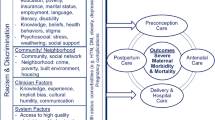Abstract
Parent–Child Assistance Program (P-CAP) is a 3-year home visitation/harm reduction intervention to prevent alcohol exposed births, thereby births with fetal alcohol spectrum disorder, among high-risk women. This article used a decision analytic modeling technique to estimate the incremental cost–effectiveness ratio and the net monetary benefit of the P-CAP within the Alberta Fetal Alcohol Spectrum Disorder Service Networks in Canada. The results indicate that the P-CAP is cost–effective and support placing a high priority not only on reducing alcohol use during pregnancy, but also on providing effective contraceptive measures when a program is launched.






Similar content being viewed by others
Notes
Assumed equal to the market basket measure threshold for lone parent with one child in Alberta in 2009 inflated to 2013 dollars.
The welfare income for lone parent with one child in Alberta in 2009 inflated to 2013 dollars.
References
Alberta FASD-CMC. (2013a). 2011/2012 Annual report. http://fasd.alberta.ca/fasd-cmc-annual-report-11-12.aspx.
Alberta FASD Service Networks. (2012). Provincial evaluation report. http://fasd.alberta.ca/publications.aspx.
Alberta’s FASD-CMC. (2013b). 2011/2012 FASD service networks annual expenditure summary. (Unpublished document).
Alberta PCAP Council. (2013). History of the Alberta PCAP Model. http://fasd.alberta.ca/provincial-initiatives.aspx.
Aronson, M., Kyllerman, M., Sabel, K. G., Sandin, B., & Olegård, R. (1985). Children of alcoholic mothers. Developmental, perceptual and behavioural characteristics as compared to matched controls. Acta Paediatrica Scandinavica, 74(1), 27–35.
Astley, S. J. (2010). Profile of the first 1,400 patients receiving diagnostic evaluations for fetal alcohol spectrum disorder at the Washington State Fetal Alcohol Syndrome Diagnostic & Prevention Network. The Canadian Journal of Clinical Pharmacology, 17(1), e132–e164.
Autti-Rämö, I. (2000). Twelve-year follow-up of children exposed to alcohol in utero. Developmental Medicine and Child Neurology, 42(6), 406–411.
Autti-Rämö, I., Korkman, M., Hilakivi-Clarke, L., Lehtonen, M., Halmesmäki, E., & Granström, M. L. (1992). Mental development of 2-year-old children exposed to alcohol in utero. Journal of Pediatrics, 120(5), 740–746.
Borenstein, M., Hedges, L. V., Higgins, J. P. T., Rothstein, H. R. (2013). Introduction to meta-analysis. http://www.meta-analysis.com/downloads/Intro_Models.pdf.
Briggs, A., Claxton, K., & Sculpher, M. (2006). Decision modelling for health economic evaluation. Oxford: Oxford University Press.
CADTH. (2006). Guidelines for the economic evaluation of health technologies: Canada (3rd Ed.). Canadian Agency for Drugs and Technologies in Health, Ottawa. http://www.cadth.ca/media/pdf/186_EconomicGuidelines_e.pdf.
Ernst, C. C., Grant, T. M., Streissguth, A. P., & Sampson, P. D. (1999). Intervention with high-risk alcohol and drug-abusing mothers: II. Three-year findings from the Seattle model of paraprofessional advocacy. Journal of Community Psychology, 27(1), 19–38.
Godel, J. C., Lee, B. E., McCallum, D. E., et al. (2000). Exposure to alcohol in utero: Influence on cognitive function and learning in a northern elementary school population. Paediatrics and Child Health, 5(2), 93–100.
Grant, T. M., Ernst, C. C., & Streissguth, A. P. (1996a). An intervention with high risk mothers who abuse alcohol and drugs: The Seattle advocacy model. American Journal of Public Health, 86(12), 1816–1817.
Grant, T. M., Ernst, C. C., Streissguth, A. P., Phipps, P., & Gendler, B. (1996b). When case management isn’t enough: A model of paraprofessional advocacy for drug- and alcohol-abusing mothers. Journal of Case Management, 5(1), 3–11.
Grant, T. M., Ernst, C. C., Streissguth, A. P., & Stark, K. (2005). Preventing alcohol and drug exposed births in Washington State: Intervention findings from three Parent-Child Assistance Program sites. The American Journal of Drug and Alcohol Abuse, 31, 471–490.
Kuehn, D., Aros, S., Cassorla, F., et al. (2012). A prospective cohort study of the prevalence of growth, facial, and central nervous system abnormalities in children with heavy prenatal alcohol exposure. Alcoholism, Clinical and Experimental Research, 36(10), 1811–1819.
Kyllerman, M., Aronson, M., Sabel, K. G., Karlberg, E., Sandin, B., & Olegård, R. (1985). Children of alcoholic mothers. Growth and motor performance compared to matched controls. Acta Paediatrica Scandinavica, 74(1), 20–26.
McLellan, A. T., Kushner, H., Metzger, D., et al. (1992). The fifth edition of the addiction severity index. Journal of Substance Abuse Treatment, 9(3), 199–213.
National Council of Welfare. (2011). Welfare income 2009—update as March 2011. http://epe.lac-bac.gc.ca/100/205/301/ncw-cnb/2012-09-27/www.ncw.gc.ca/servlet/welfare_incomes_2009_update_as_of_march_2011.pdf.
Pelech, W., Pei, J., & Poth, C. (2013). Year 5 evaluation of the government of Alberta’s FASD 10 year strategic plan. Outcome 1b. Edmonton: Alberta Center for Child, Family & Community Research.
Rasmussen, C., Kully-Martens, K., Denys, K., et al. (2012). The effectiveness of a community-based intervention program for women at-risk for giving birth to a child with fetal alcohol spectrum disorder (FASD). Community Mental Health Journal, 48, 12–21.
Statistics Canada. (2013). Consumer price index, historical summary. http://www.statcan.gc.ca/tables-tableaux/sum-som/l01/cst01/econ46a-eng.htm.
Thanh, N. X., Jonsson, E., Dennett, L., & Jacobs, P. (2011). Costs of FASD. In E. P. Riley, S. Clarren, J. Weinberg, & E. Jonsson (Eds.), Fetal alcohol spectrum disorder—Management and policy perspectives of FASD (pp. 45–69). Hoboken: Wiley-Blackwell.
Acknowledgments
This study is financially supported by Alberta Health. We are grateful to Teresa O’Riordan, Executive Director of the Northwest Central Alberta FASD Network, Dr. Arto Ohinmaa, University of Alberta School of Public Health, and Dr. Philip Jacobs, University of Alberta Dept. of Medicine, for providing valuable information.
Author information
Authors and Affiliations
Corresponding author
Rights and permissions
About this article
Cite this article
Thanh, N.X., Jonsson, E., Moffatt, J. et al. An Economic Evaluation of the Parent–Child Assistance Program for Preventing Fetal Alcohol Spectrum Disorder in Alberta, Canada. Adm Policy Ment Health 42, 10–18 (2015). https://doi.org/10.1007/s10488-014-0537-5
Published:
Issue Date:
DOI: https://doi.org/10.1007/s10488-014-0537-5



